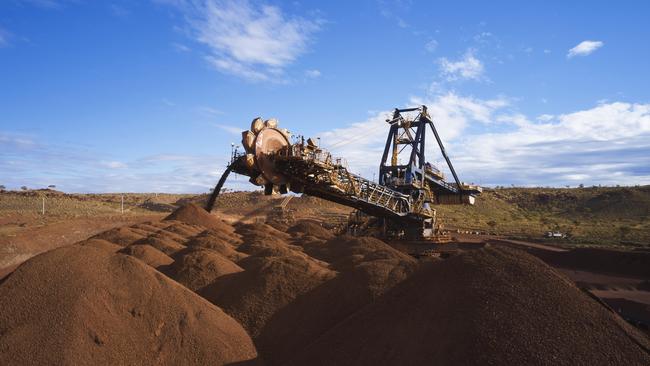Fortescue to make deep cuts to management ranks as iron ore price falls
Fortescue’s sweeping restructure goes far beyond removing the duplication of backroom functions between its energy and mining arms, with the company sweeping out layers of management.

Fortescue’s sweeping restructure goes far beyond removing the duplication of back room functions between its energy and mining arms, with a growing number of senior executives set to depart as the company sweeps out layers of management.
The cost-cutting comes as the iron ore price dipped below $US100 a tonne this week in the wake of market disappointment that a major Chinese Communist Party policy meeting, the third plenum, failed to deliver major stimulus packages that might help kickstart the country’s ailing construction sector.
Fortescue said last week that it will finalise its restructuring package by the end of the month, with as many as 700 staff set to depart.
That process is still ongoing, the company said on Wednesday, and some staff initially slated for departure may still be offered alternative roles.
“As we announced last week, as part of our transition to a One Fortescue model we are simplifying and streamlining our structure, removing roles from all levels of the organisation, to ensure we are lean, impactful and can move quickly to seize opportunities,” the company said.
But The Australian understands several senior executives are likely to depart the company, including the director of innovation and technology – and formerly head of strategy – John Paul Olivier.
Sources say that Fortescue’s boss of its Chichester mining hub, Jay Natesan, is also set to depart the company after Fortescue re-established the role of chief operating officer to oversee its mining operations, handing the position to former Mineral Resources executive Shelley Robertson.
Also slated to depart, sources say, are global health and safety boss Zara Fisher, and the general manager of the company’s remote operations centre.
Fortescue said last week the restructure was largely aimed at ending the duplication of human resources, finance and other support roles such as communications between its green energy and mining arms – as well as “the simplification of its structure to ensure it remains lean, impactful and agile”.
But The Australian understands that that simplification will include sweeping away a large section of its middle management, with the company looking to reduce the number of roles at general manager level or above from about 130, down to about 40.

Fortescue is set to deliver its financial year production figures on Thursday, amid widespread expectations the company will miss the 192 million-tonne bottom end of its annual production guidance, with consensus expectations suggesting the company will only barely break the 190 million-tonne mark.
If realised, the production slip would come as pricing for Fortescue’s lower-grade ores comes under greater pressure, analysts say, amid expectations the slowdown in the Chinese steel industry will translate into lower iron ore pricing.
That has traditionally translated into a widening gap between pricing for higher-grade product and lower-grade ores – such as those exported by Fortescue.
Rio Tinto noted in its June quarter production report on Tuesday that signs of a flight to quality had emerged in the period, with premiums for lump ore rising and the differential between ore grades pricing widening.
Fortescue chairman Andrew Forrest has rejected any suggestion that the restructure represents a backdown on the company’s strategy of expanding into the delivery of green energy, and Macquarie analysts noted last week that Fortescue’s share price had broken free of its traditional link to the iron ore price, suggesting that the market was valuing its green ambitions at about $4.70 a share.
“Whilst positive for earnings and free-cash flow, we recognise the short-term sugar hit to dividend yields may be received well by investors looking to harvest fully franked returns,” Macquarie analysts said in a client note.
“However, ETFs seeking hydrogen exposure, or ‘long onlys’ with strong energy transition mandates may seek to reduce positions on these developments and a slowing of Fortescue’s external green energy business trajectory.”
A sharp iron ore price fall beneath $US100 a tonne would dent Fortescue’s returns, but not its viability. Macquarie estimates Fortescue’s break even price at about $US40 a tonne – higher than that of BHP at about $US32 and Rio at about $US35.
“Fortescue has addressed market downturns in the past with a focus on cost and flexibility. With the recent Simandou approval and a higher break-even vs peers, FMG’s premium may come under pressure,” Macquarie analysts said.
Fortescue shares closed up 11c on Wednesday at $21.32.




To join the conversation, please log in. Don't have an account? Register
Join the conversation, you are commenting as Logout